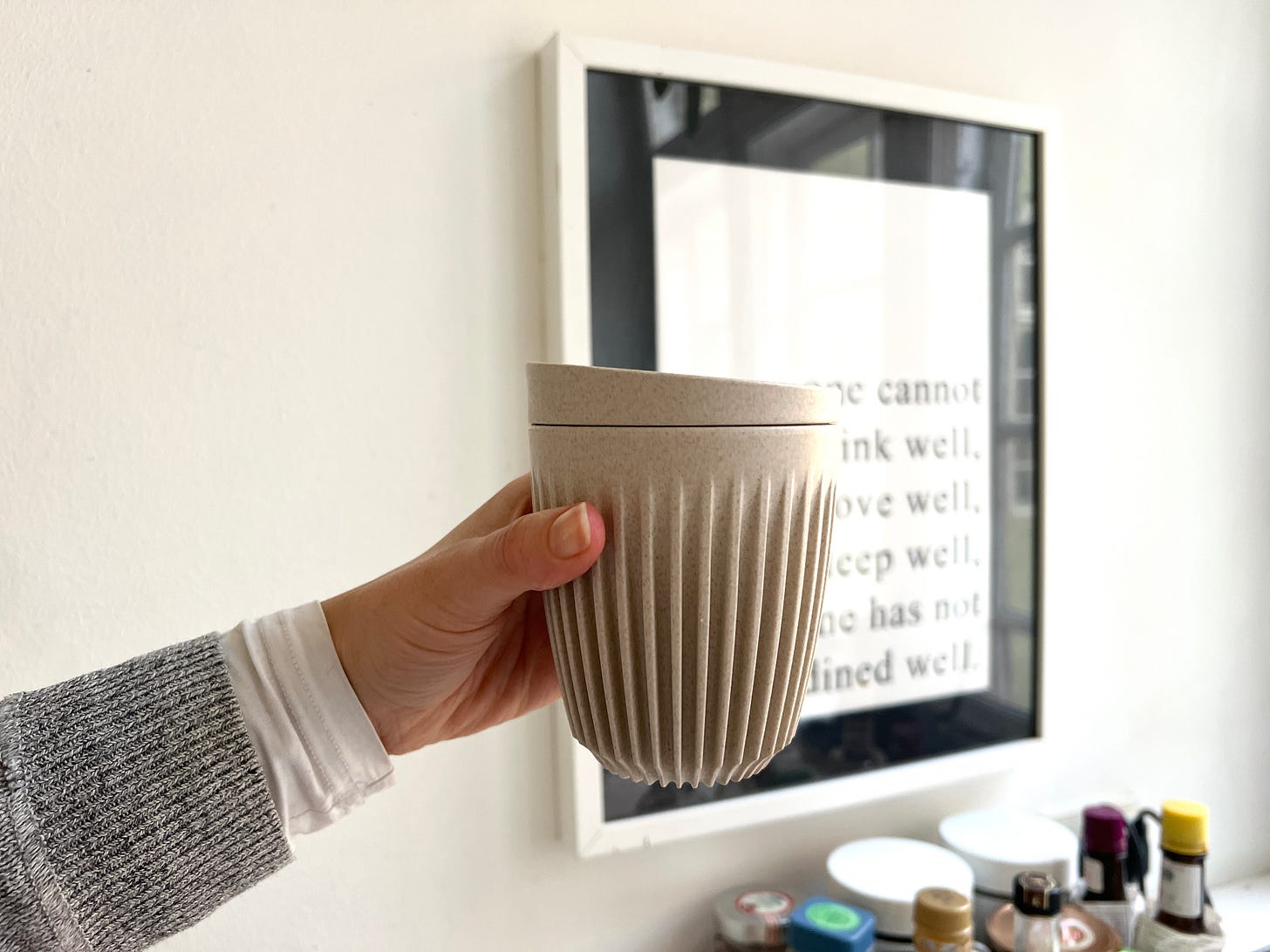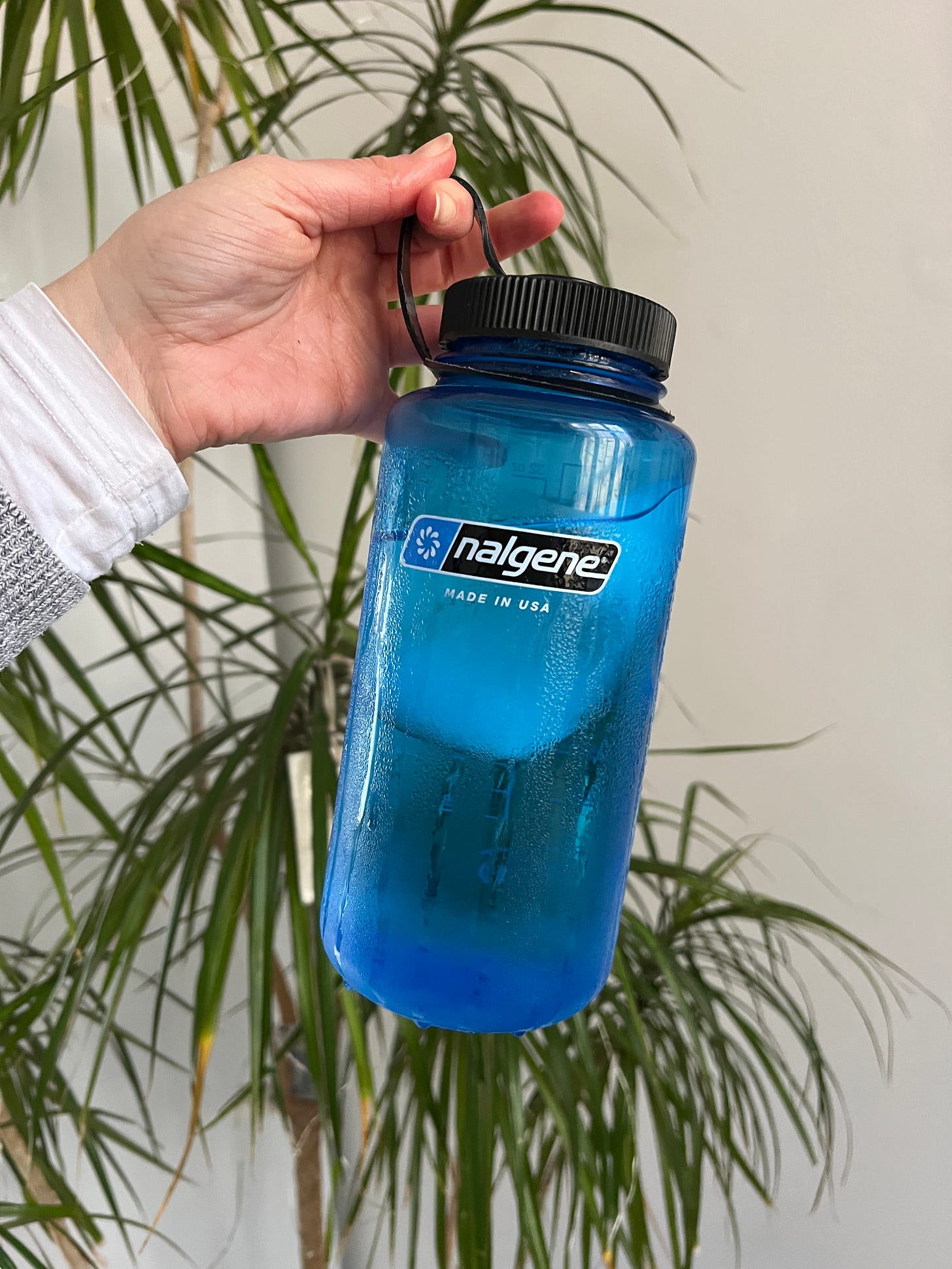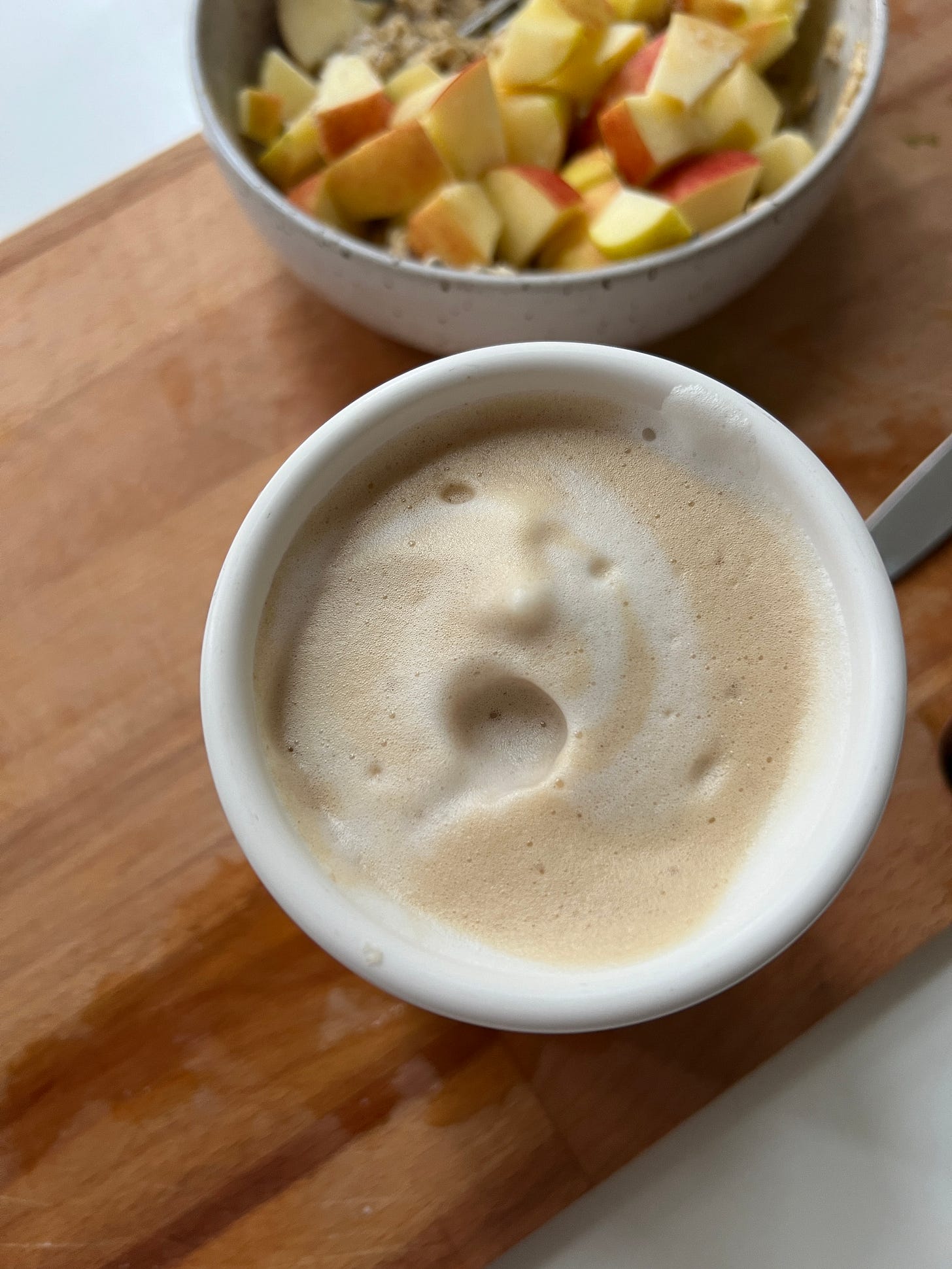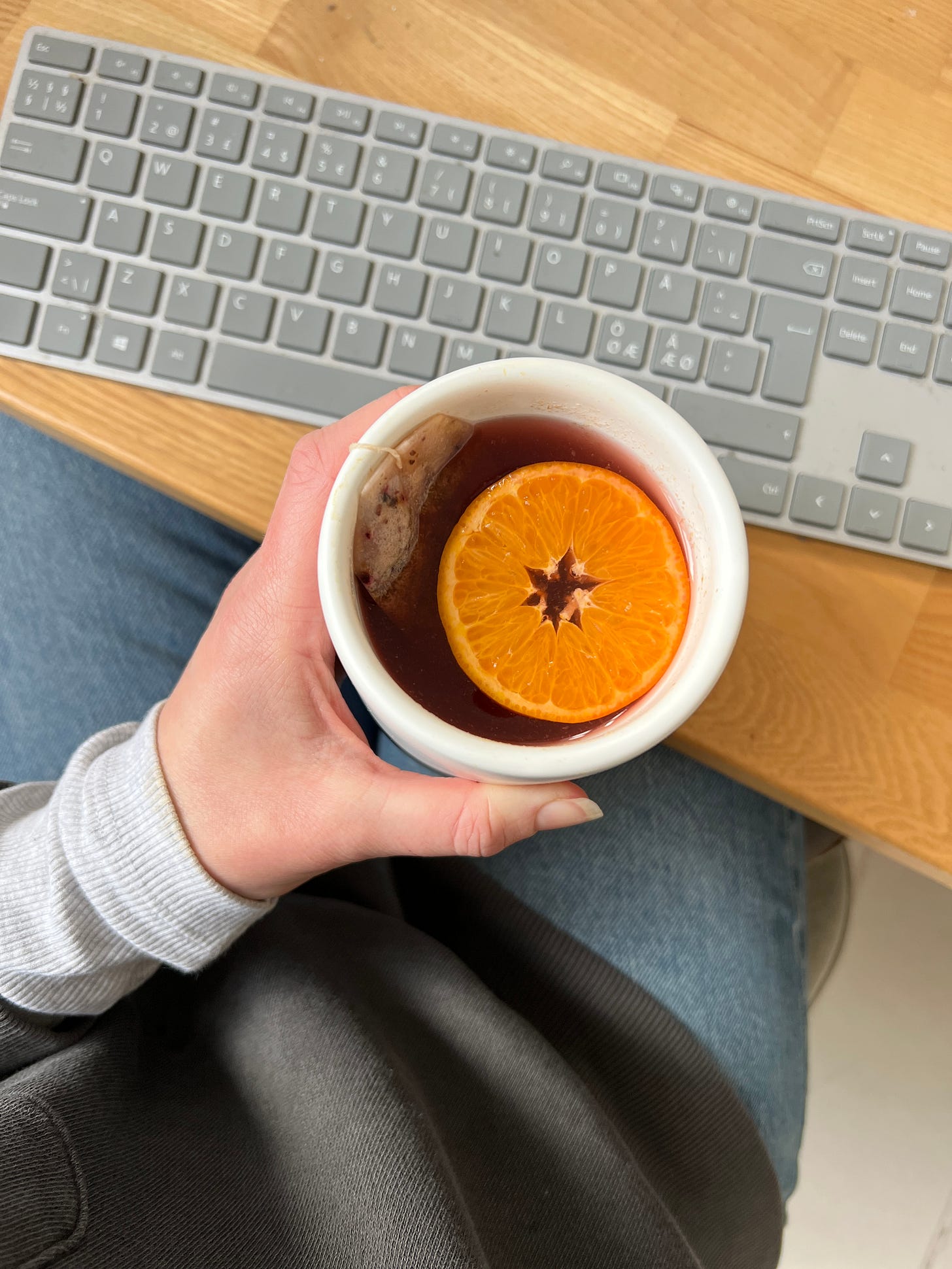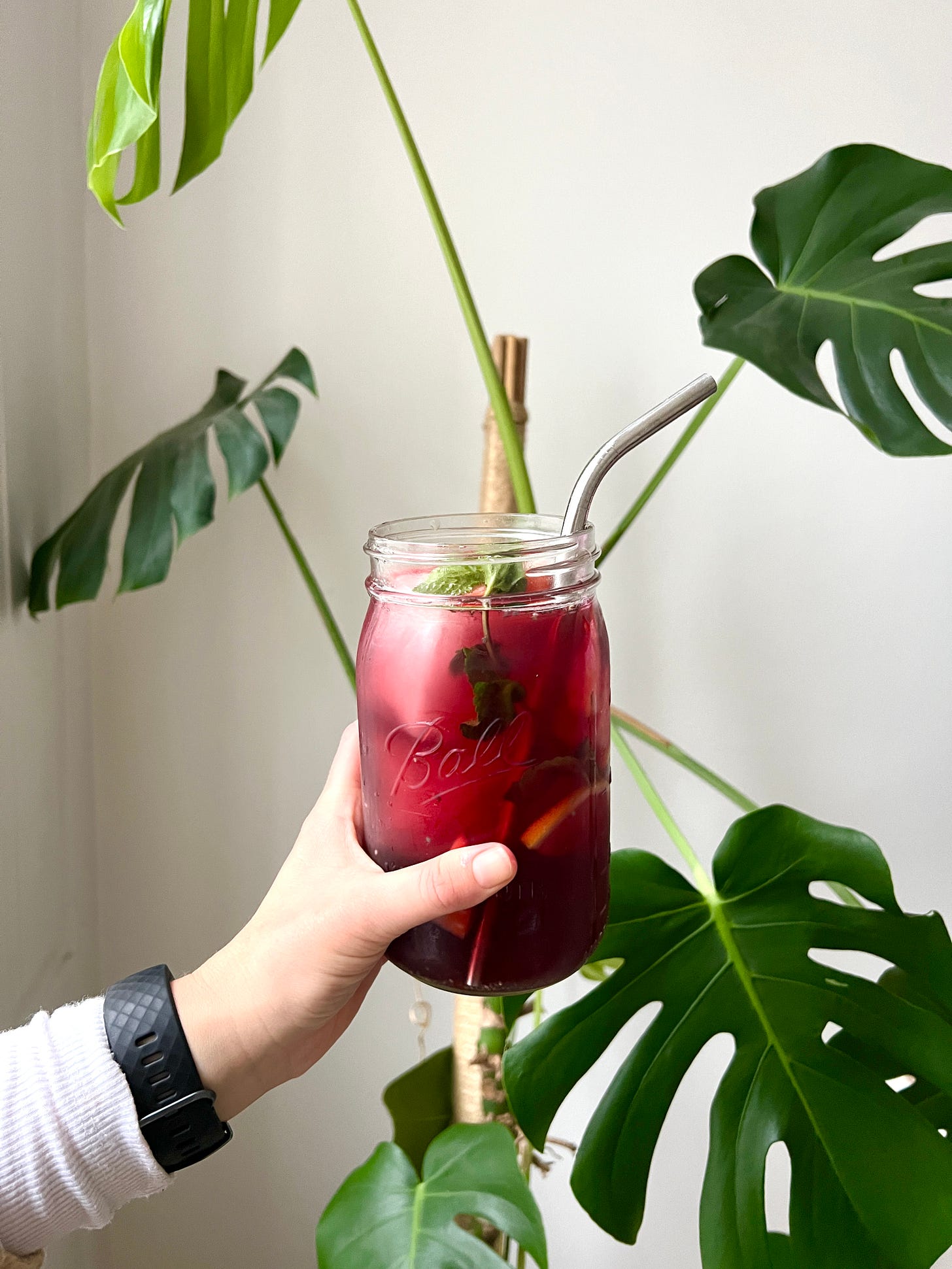A Day in My (Hydrated) Life 💦
How hydration impacts productivity -- complete with time-stamps, photos, and recipes!
Roughly 75% of American adults are living with chronic mild dehydration — defined as losing more fluids than you take in, this type of dehydration can happen gradually, and we might exist in this state for years or even decades.
And while you might think of a pounding headache, dark undereye circles, chapped lips, dry skin, or dizziness when you think of dehydration, the symptoms of chronic mild dehydration can look more like:
🥱 Fatigue
😵 Brain fog
😑 Bloating
🤬 Moodiness
😷 Bad breath
😳 Trouble sleeping
💪🏻 Joint pain
💅🏻 Brittle nails/hair
🧡 Heartburn
🤨 Unexpected weight gain
🤒 Poor immunity
The impact can be more than just physical…it can impact us cognitively, too. Making consistent hydration a vital part of feeling energized, focused, and productive!
Which is why you’ve heard me say this repeatedly over the past decade: hydration is one of the simplest, fastest, and most affordable ways to improve how we look, feel, and perform.
I can teach you tech tips + productivity hacks all day — but hydration might be the secret weapon you’re actually looking for.
So today, I thought I’d take you along on an average day in my (hydrated) life and show you what it looks like to support my energy and productivity with hydration — complete with time-stamps, photos, and recipes!
Rest assured, your day doesn’t need to look identical to mine—and every day can (and should) look different. This got a bit long and may appear clipped via email — so be sure to hit “view entire message” if needed. Hope this inspires new ways for you to support your work through hydration. Let’s get going…
🌙 THE NIGHT BEFORE
I have three things I do in the evening to set myself up for a hydrating day:
I put about 10 oz. of water into my Nalgene bottle, and set it in the freezer at a 45 degree angle (so the water freezes like a slanted wedge of ice. This is key for not dousing yourself with ice water at the gym tomorrow).
I set my Huskee travel mug on the counter, add 1/2 tsp of chia seeds and a pinch of sea salt to it, and pre-fill our electric kettle with water.
I fill up my designated water cup (I use this 24 oz Bubba Tumbler, $9) and put it next to my bed.
🍋 5:15 AM: MORNING WATER
1/2 tsp chia seeds
Pinch of sea salt
1/2 tsp lemon juice
6 oz. hot waterTip: Freeze the ingredients into ice cubes, then simply pour hot water over them.
It’s a Monday, so my alarm goes off around 5 AM as I like to be at the gym by 5:30. I’m always a little thirsty when I wake up, so I have a quick sip from the tumbler next to my bed, and spend just 30 seconds stretching before I get up.
As you’ll soon discover, my approach to hydration is about way more than just chugging water. Optimal hydration looks like:
💦 Drinking water along with a balance of fiber, electrolytes, and minerals.
🍎 Eating water in the form of plants.
👟 Moving water with gentle, consistent movement.
My first gentle movement of the day is called “Chin to Chest”. You just pick your head up and try to touch your chin to your chest. Then gently lower it again. This move uses your head as a priming weight to pump fresh fluids throughout your spinal canal after a night of sleep (Quench, p. 185).
I can be out the door 7 minutes after my alarm goes off if I’m efficient 🤓 So that means turning on the electric kettle before I brush my teeth, toss on my gym clothes, and put my hair up.
My travel mug is sitting on the counter, acting as a visual cue to remind me to make Morning Water. Since the chia seeds and sea salt are already in the cup, I add a squeeze of lemon, 6 ounces of hot water from the kettle, and give it a quick stir.
I grab my Nalgene bottle from the freezer, complete with the ice wedge we made last night, and top it off with water from the tap. Once I toss that in my backpack and get my shoes on, I’m ready to go.
It’s a short, 8-minute walk along Frederiksholms Kanal to my gym, and I choose to walk as it’s a nice warm-up, but also helps get fluids moving throughout all my tissues.
Morning Water gives your body exactly what it needs thanks to the fiber (chia seeds), electrolytes (sea salt), and minerals (lemon juice) which can help prime your system. My goal is to drink the Morning Water by the time I get to the gym.
🧊 5:30 AM: ICY COLD NALGENE
While I’m at the gym (for an hour or so) I sip on my Nalgene . I mostly do weightlifting, so I don’t usually consume a ton of water, but will likely have 10-12 ounces from my Icy Cold Nalgene while I’m there.
I love the Icy Cold Nalgene trick for a couple reasons: freezing it at night is like a little promise to myself that I’m getting up and going to the gym, and each icy sip is a gift to future Dani while she’s working out. Sounds wild, but works for me.
💦 7:00 AM: DESIGNATED WATER CUP
When I get home I’ll dump any remaining water from the Icy Cold Nalgene into my designated water cup. And before we move on, let’s talk about a designated water cup.
The Stanley Cup obsession made the designated water cup into a comical pop culture reference instead of the useful tool it can be for so many people, so let’s be clear about what it is and isn’t.
A designated water cup can be any vessel you prefer. It doesn’t need to look or perform any certain way, can be any size that works for you, and can be affordable (my favorite cup that I’ve used for over a decade costs $9).
The goal is to keep it handy throughout the day, so that water is accessible to you. There’s no need to lug it everywhere, but keep it in places where you’re spending extended time.
When we are chronically dehydrated, our brain learns to “turns down the volume” on our natural thirst cues. The main purpose of a designated water cup is creating a visual cue that lets your brain know that water is available to you, which can help restore those natural cues. The cup is NOT to help you chug 60, 90, or 120 ounces of plain water per day.
Simply take a sip when you notice early signs of mild dehydration, which might be different from what you’ve heard or been taught. The early signs of mild dehydration are:
🥱 Fatigue
🤬 Moodiness
😵 Brain fog
You feel any of those?! You take a lil sip of water. I’m not obsessive about my designated water cup, but it’ll move with me throughout most of my day. It’s usually in the kitchen when I’m cooking, on my desk when I’m working, near the couch when I’m watching TV, and next to the bed when I sleep. Mine is 24 ounces and I typically finish 2-3 of them each day.
☕ 8:00 AM: ORANGE MAPLE LATTE + BREAKFAST
4 oz. strong coffee or espresso
1 tsp of pure maple syrup for sweetness
Small squeeze of fresh orange juice (like 1/3 a clementine)
4 ounces frothed whole milk.P.S. If you think the orange in your coffee is weird you can skip it. But don’t knock it til you try it! It really adds a fun pop of flavor that can draw out the citrus notes in your coffee.
Once I’m ready for the day, I’ll make breakfast along with a Maple Latte. Breakfast is usually something like Cinnamon Apple Oats or an Egg Scramble with Veggies — both loaded with hydrating benefits!
No matter what I eat for breakfast, I make sure it includes a hefty serving or two of plants! These are an important part of hydration, as they provide you with water perfectly packaged with a balance of electrolytes and minerals.
I typically pair my breakfast with a latte, and I’m pleased to inform you that coffee is not dehydrating.
A 2016 randomized controlled trial, showed that 16 ounces of coffee is almost as hydrating as 16 ounces of water. Coffee, overall, has a net hydrating effect.
What you do want to be aware of, is the amount of coffee you drink per day and the things you add to the coffee.
Try to keep it around 400 milligrams of caffeine per day — that’s about 4 cups of brewed coffee or two shots of espresso. More caffeine than that, and you’re likely not getting enough variety in your beverages.
If you use caffeine for energy, lean on the fact that HYDRATION can provide you with a stronger, more sustainable boost of energy.
🍊10:00 AM: ORANGE CINNAMON CRANBERRY TEA
Add a tea bag to a cup (any fruit or berry variety will do! Today I’m using Cran-Apple)
Top with 6 oz. of hot water and allow it to steep
Add a squeeze of fresh orange juice (like 1/2 a clementine)
Pinch of cinnamon
Slice of orange
Optional: Top with a splash of cranberry juice if you want extra flavor
By 10 AM I’m ready to get up from my desk and move a little bit, and Walter (my dog!) is ready for his morning potty break. I’ll turn the kettle on as we pass through the kitchen, and by the time we return from a quick trip outside it’s ready to go and I make the recipe above.
The 3-4 minute trip outside is also a good excuse for mini-movements. I go up and down the stairs with Walter (often carrying him on the way up), but while he’s doing his business I focus on stretching my neck, moving my arms, and twisting my spine. These mini-stretch sessions help keep fresh fluid freely moving throughout your body.
The tea is a nice mid-morning pick-me-up that can help curb that second-morning-coffee craving while giving you another boost of electrolytes, fiber, and minerals to keep you cognitively sharp.
🥗 11:30: LUNCH
I have a client call every day at 12, so I try to squeeze lunch in around 11:30. I don’t usually pair an exciting beverage with my lunch, but instead focus once again on getting plenty of plants into my meal.
Delicious, exciting, nutrient-dense salads are one of my go-tos, and this post I wrote about making Salads That Don’t Suck has all my best tips.
I usually keep a couple pre-cooked protein options in the fridge, so I can toss lunch together quickly without needing to cook or create a mess in the kitchen. Today’s lunch was an Asian-inspired salad with chicken, fresh snap peas, cucumbers, cashews, and a homemade ginger soy dressing.
✨ 2:30 PM: HYDRATION POTION + SNACK
In a large glass or jar, add:
Ice cubes
Pinch of sea salt
Source of fiber (chia seeds, ground flax or pepitas etc.)
Add 1-2 tbsp unsweetened berry or fruit concentrate
Squeeze in fresh citrus (lemon, lime, orange, etc.)
Add fresh fruit or veggies (strawberries, cucumbers etc.)
Add herbs if desired (mint, rosemary, ginger, cinnamon!)
Add honey or maple syrup if you want it sweetened (optional)
Top with still, sparkling, or coconut water and enjoy!Tip: Pre-mix this into bottles or jars so it’s ready to go and easy to take with you to work — keep it in the fridge for up to a week.
After my client call, another hour of work, and a quick 25-minute afternoon walk with Walter, I’m smack-dab in the middle of The Afternoon Slump. While most of us associate this with a need for caffeine, it’s also the point in the day when many people are mildly dehydrated (which can feel like a “slump” thanks to the brain fog and fatigue!).
Hydration Potion is a great way to curb both an afternoon slump or caffeine craving, while once again perking yourself up with water, electrolytes, fiber, and minerals.
I’ll also have a simple afternoon snack — usually some sort of snack plate comprised of apple slices, peanut butter, veggies, hummus, nuts, and cheese. These two things help power me through another hour of work before running some quick errands and picking up groceries in the late afternoon (all by foot or bike, since we don’t have a car).
🍽 5:30 PM: DINNER
Again this meal doesn’t have an exciting beverage paired with it, and we usually just drink tap water with our dinner (#boring)!
When I feel like elevating it a bit I’ll fill stemmed glasses with still or sparkling water, add ice cubes, or a garnish like mint. A couple times a month we will have a small glass of wine or fun cocktail with dinner.
Just like other meals, dinner will be balanced and will contain plenty of plants. Rice bowls, curries, and stir-fries are go-to dinner recipes at our house. On this night we had Salmon with Coconut Rice and Spicy Cilantro Sauce. Veggies mixed into the rice were broccoli, peppers, onion, garlic, and spinach (I’ll share this full recipe in a post soon!).
😄 7:30 PM: BUBBLE WATER OR TEA + SNACK
When we sit down in the evening to watch a show, work on a puzzle, or play cards I usually dive into a final beverage for the day.
Go-tos would be flavored bubble waters (like LaCroix, Spindrift, Noda, San Pellegrino etc.), or simply combining juice + plain bubble water over ice. They pair nicely with the drama of Love is Blind, you know?
Sometimes I’ll enjoy a cup of tea, such as ginger or chamomile, before bed to help induce sleep instead.
Our evening snack varies, but right now we are very into what we have been calling “A Snackuterie Board”. We put some of our favorite snacks (chocolate! gummies!) into small dishes, paired with balanced, hydrating options like nuts + fruit.
I try to finish my last beverage an hour before bedtime, to avoid being woken up by a bathroom break.
🌙 9:00: GOODNIGHT
Do I really go to bed at 9:00? Yes. And I go to bed well hydrated.
So much important stuff happens when we sleep, including our glymphatic system. The glymphatic system was discovered by Danish neuroscientist Maiken Nedergaard in 2012 and operates similarly to our lymph system, but drains waste products solely from the brain. When we sleep, fluid flow in our brain increases by at least 60% (source), and is the primary time our body is able to deep clean cellular waste and other debris from our brain tissue.
Going to bed dehydrated means this cleaning cycle can be impaired, impacting our sleep quality and leaving us groggy and tired the next day, but also potentially contributing to various diseases.
Before hitting the hay, I once again do these three things to set myself up for a hydrating day:
I put about 10 oz. of water into my Nalgene bottle, and set it in the freezer at a 45 degree angle. I won’t go to the gym tomorrow, but Josh will so this one’s for him (we alternate days so the other is in charge of Walter’s morning walk).
I set my Huskee travel mug on the counter, add 1/2 tsp of chia seeds and a pinch of sea salt to it, and pre-fill our electric kettle with water. If not going to the gym, I’ll sip it while doing some Tuesday morning yoga + stretching.
I fill up my designated water cup (I use this 24 oz Bubba Tumbler, $9) and put it next to the bed.
All the planning products in my shop are designed to support you in having a hydrated day. Note how the hydration section encourages various types of beverages and reminds you to consider how nutrition impacts your hydration, as well.
There ya have it! A detailed peek at a hydrating day in my life! Itemized, todays intake looked something like this:
Sips of water via my designated water cup: 48 oz.
Icy Cold Nalgene: 10 oz.
Morning Water: 6 oz.
Orange Maple Latte: 8 oz.
Orange Cinnamon Cranberry Tea: 8 oz.
Hydration Potion: 16 oz.
Can of Noda: 10 oz.
Each day is different, and while I average 80-100 ounces per day for all fluids I consume, that flexibility is important because our needs change everyday!
Our body’s need for hydration is impacted by our activity level, size, diet, mood, the weather outside, the temperature inside, our occupation, stress level, menstrual cycle and so much more! Knowing how to listen to your body and meet it’s unique needs is all part of the process, but a general guideline is that you should try to get at least 1/2 oz. of hydration for every pound of body weight (150 lb. person = 75 ounces per day).
Other beverages that I rotate in:
Smoothie
Green Juice
Agua Fresca
Iced Tea or Coffee in the summer
Tea Coolers (tea + frothed milk)
Keep scrolling for:
📚 A PDF that features my favorite 3 hydrating recipes, my infused water cheat sheet, and my hydrating shopping list!
❓ My FAQ where I’ll answer questions such as:
What to do if you’re in a career with inconsistent bathroom access (such as teaching or nursing)
How to support hydration in the workplace for your team and co-workers
How to stay hydrated when drinking alcohol
Why optimal hydration won’t make you pee constantly (at least not forever)
Why drinking more water can cause a headache
What to do if you don’t like the taste of water
+ Ask me your own questions in the comments
Keep reading with a 7-day free trial
Subscribe to Thyme is Honey to keep reading this post and get 7 days of free access to the full post archives.





